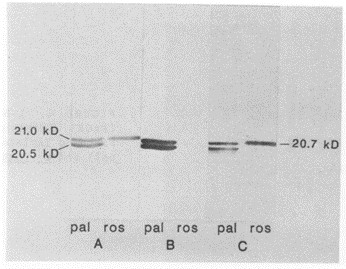A quick and reliable routine test to identify nematodes is of great importance. Morphological species differentiation is arduous and not entirely reliable because of intra-and interspecific variations in shape and size. Differentiation based on biochemical or serological entities should offer better prospects. Immunoassays have great applications in agriculture for diagnosing crop diseases, pesticides, and other natural compounds. Since the generation of anti-nematode antibodies was first reported, several researchers have demonstrated promising results with the use of polyclonal and monoclonal antibodies (mAbs).
Lifeasible is committed to helping our customers achieve effective and successful research. We provide convenient and guaranteed detection of plant nematodes with serological analyses. In addition, we deliver reliable results and reports on time to our customers worldwide.
 Fig.1 SDS-PAGE of plant nematodes protein followed by immunoblotting. (Schots A, et al., 1989)
Fig.1 SDS-PAGE of plant nematodes protein followed by immunoblotting. (Schots A, et al., 1989)
| Steps | Operation Methods |
| Antigen Preparation and Immunization of Animal |
|
| Preparation of Monoclonal Antibodies |
|
| Determination of Cross-Reactivity |
|
| Calculation of Binding Constants | Antibody binding constants are calculated from the results of a direct ELISA. |
| Electrophoresis and Blotting |
|
Lifeasible has extensive experience and expertise in plant science. We are committed to providing you with timely and high-quality deliverables. At the same time, we guarantee the cost-effectiveness, completeness, and simplicity of the report. If you are interested in our services or have any questions, please feel free to contact us or make an online inquiry.
Reference
Lifeasible has established a one-stop service platform for plants. In addition to obtaining customized solutions for plant genetic engineering, customers can also conduct follow-up analysis and research on plants through our analysis platform. The analytical services we provide include but are not limited to the following:
STU-CRISPR System Improves Plant Genome Editing Efficiency
April 19, 2024
Application of Exosomes in Facial Beauty
April 12, 2024